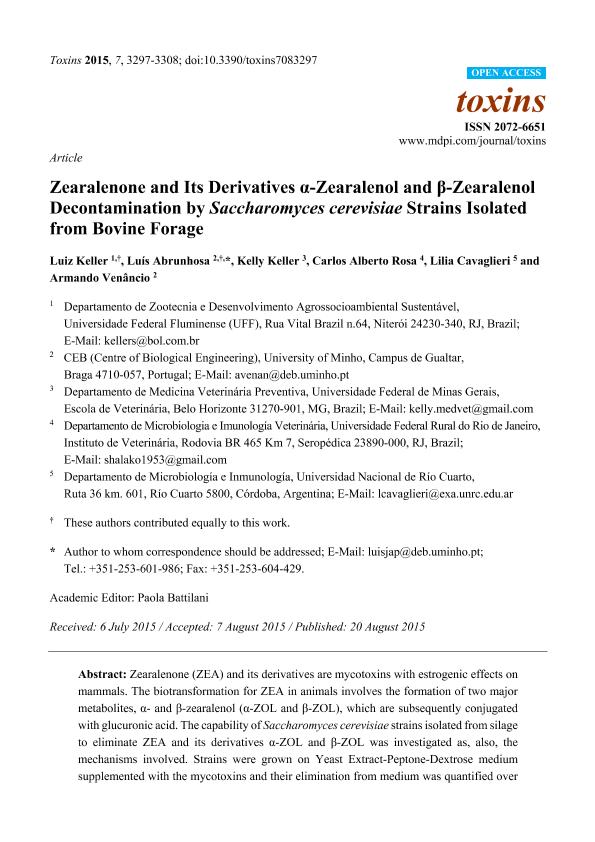Artículo
Zearalenone and its derivatives α-zearalenol and β-zearalenol decontamination by Saccharomyces cerevisiae strains isolated from bovine forage
Keller, Luiz; Abrunhosa, Luís; Keller, Kelly; Rosa, Carlos Alberto; Cavaglieri, Lilia Reneé ; Venâncio, Armando
; Venâncio, Armando
 ; Venâncio, Armando
; Venâncio, Armando
Fecha de publicación:
08/2015
Editorial:
MDPI
Revista:
Toxins
ISSN:
2072-6651
Idioma:
Inglés
Tipo de recurso:
Artículo publicado
Clasificación temática:
Resumen
Zearalenone (ZEA) and its derivatives are mycotoxins with estrogenic effects on mammals. The biotransformation for ZEA in animals involves the formation of two major metabolites, α- and β-zearalenol (α-ZOL and β-ZOL), which are subsequently conjugated with glucuronic acid. The capability of Saccharomyces cerevisiae strains isolated from silage to eliminate ZEA and its derivatives α-ZOL and β-ZOL was investigated as, also, the mechanisms involved. Strains were grown on Yeast Extract-Peptone-Dextrose medium supplemented with the mycotoxins and their elimination from medium was quantified over time by HPLC-FL. A significant effect on the concentration of ZEA was observed, as all the tested strains were able to eliminate more than 90% of the mycotoxin from the culture medium in two days. The observed elimination was mainly due to ZEA biotransformation into β-ZOL (53%) and α-ZOL (8%) rather than to its adsorption to yeast cells walls. Further, the biotransformation of α-ZOL was not observed but a small amount of β-ZOL (6%) disappeared from culture medium. ZEA biotransformation by yeasts may not be regarded as a full detoxification process because both main end-products are still estrogenic. Nonetheless, it was observed that the biotransformation favors the formation of β-ZOL which is less estrogenic than ZEA and α-ZOL. This metabolic effect is only possible if active strains are used as feed additives and may play a role in the detoxification performance of products with viable S. cerevisiae cells.
Palabras clave:
Adsorption
,
Detoxification
,
Saccharomyces Cerevisiae
,
Zea
,
Α-Zol
,
Β-Zol
Archivos asociados
Licencia
Identificadores
Colecciones
Articulos(CCT - CORDOBA)
Articulos de CTRO.CIENTIFICO TECNOL.CONICET - CORDOBA
Articulos de CTRO.CIENTIFICO TECNOL.CONICET - CORDOBA
Citación
Keller, Luiz; Abrunhosa, Luís; Keller, Kelly; Rosa, Carlos Alberto; Cavaglieri, Lilia Reneé; et al.; Zearalenone and its derivatives α-zearalenol and β-zearalenol decontamination by Saccharomyces cerevisiae strains isolated from bovine forage; MDPI; Toxins; 7; 8; 8-2015; 3297-3308
Compartir
Altmétricas



